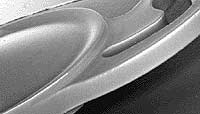Design issues can affect PCO in one-piece lenses
Rabbit study shows that 360° square edges may help reduce secondary cataract.
SAN FRANCISCO – Some one-piece IOL designs may protect better against posterior capsular opacification than others, recent studies suggest.
Cataract surgeons have already observed that a square-edged optic can help to protect against PCO. Beginning with studies in Japan in the last decade, several surgeons have described how a square-edged optic can help create a barrier against cell migration.
|
|
Now David J. Apple, MD, and colleagues are testing the hypothesis that the square edge must be continuous for 360° around the lens for the PCO barrier to be most effective. Dr. Apple, along with coinvestigators Nick Mamalis, MD, Liliana Werner, MD, PhD, Suresh K. Pandey, MD, and Andrea M. Izak, MD, have noted that some one-piece foldable lenses have optic-haptic junctions where the edge is not square. This region might therefore represent a pathway where cellular growth onto the posterior surface of the IOL can occur, they hypothesize.
Dr. Apple said several one-piece foldable IOL designs are now being tested, not only in large clinical studies but also in lab studies, to ascertain their effectiveness against PCO.
“We’ve come up with a new theory that lenses with incomplete square edges may have a potential weakness or an “Achilles’ heel” right at the haptic-optic junction where the haptic meets the optic, where the protection of the square edge is lacking,” Dr. Apple said here at the American Society of Cataract and Refractive Surgeons meeting.
To test this theory, Dr. Apple and colleagues modified a one-piece foldable IOL, creating a prototype lens with a 360° square posterior edge. They tested the lens in rabbits and found that the PCO rate was lower with the continuous square edge than with the classic lens of this style in which the edge at the optic-haptic junction is round.
Dr. Apple referred to a report given at ASCRS by English researchers the day before his presentation here. In it, the authors had compared PCO rates of patients implanted with either the Rayner Centerflex one-piece hydrophilic lens or the Alcon AcrySof one-piece hydrophobic acrylic lens. The Alcon lens also has a rounded optic edge at the optic-haptic junction, but a much smaller one, Dr. Apple noted. The London researchers found that the Rayner IOL was associated with higher and worse incidence of PCO than the AcrySof.
“From this data it might be tempting to conclude that the PCO differentiation might be ascribed solely to the biomaterial, because of the general feeling that a hydrophobic biomaterial may not be as suitable,” Dr. Apple said. “Indeed, the AcrySof biomaterial does inhibit cellular proliferation. However, there may be an additional reason, and our study validates this, that normally lens design or geometry is also a factor. The PCO could be related to the lens design as well as the material, and that was the purpose of the experimental study.”
The Rayner one-piece IOL differs from the Alcon one-piece lens in that the optic-haptic junction is larger or broader, Dr. Apple stated.
Dr. Apple reiterated that, in the classic one-piece Centerflex, “the cross section through the optic-haptic junction is not a square edge. You can see it’s a round edge tapering into the optic.”
Rabbit study
“My colleagues, in a skillfully designed animal study, tested the prototype one-piece IOL with the completely square edge,” Dr. Apple said. “They implanted both the classic and the prototype lens in rabbits and scored the results.”
“In the classic lens without the complete square edge, the PCO rate was relatively high, a unit of 0.9 in the scheme used in our laboratory. It was less than half that, a score of 0.38, with the complete square edge,” Dr. Apple said. “So, in our opinion, just by making this simple change in design, you can in essence ‘engineer’ the behavior of the lens without changing the basic biomaterial.”
Dr. Apple noted that, after Hara’s basic studies in the 1990’s, the phenomenon of the square-edged ring or optic acting as a barrier against cell migration was firmly established in studies by Nishi, Apple, Werner and associates, Menapace, Tetz, Spalton and many others with the three-piece AcrySof IOL, which has a 360° square edge. Since then, other lenses with similar edge characteristics have been shown to have improved PCO performance, although Dr. Apple said the AcrySof to date represents “the gold standard.”
Dr. Apple noted that Alcon’s AcrySof Single-Piece IOL now has a modern square edge with a “frosted” edge around the optic, except at the optic-haptic junction where it tapers into a rounded configuration.
He noted that this design characteristic is unique to one-piece IOLs. Newer designs, such as the Advanced Medical Optics OptiEdge design, also manufactured as a three-piece lens, are being tested.
“It is now clear that the concept of the square edge is now accepted by all surgeons and manufacturers,” he said. “Researchers have already documented the efficiency of the three-piece design in PCO prevention. The main thrust is to confirm that one-piece lenses do equally well or even better. The present study helps to confirm the efficacy of the one-piece lenses and helps separate out the factors that play a role in lowering PCO.”
In recent years, the incidence of PCO after lens implantation has been decreasing due to modifications in surgical technique as well as changes in both IOL design and material, according to Dr. Apple. He said the tools and techniques are available to decrease the PCO rate to single digits.
“I call it a quiet revolution because many surgeons didn’t analyze it as it was happening,” Dr. Apple said.
“As we move ahead in designing new lenses, biomaterials, anything,” he said, “we’re talking about something analogous to genetic engineering where we have to titrate changes both in design and in materials to put the thing together into one final, excellent project.”
For Your Information:References:
- David J. Apple, MD, is professor of ophthalmology and pathology and director of the David J. Apple, MD, Laboratories for Ophthalmic Device Research at the John A. Moran Eye Center, 50 North Medical Drive, 5th Floor, Salt Lake City, UT 84132; (801) 581-8136; fax: (801) 581-3357.
- Apple DJ, Peng Q, et al. “Eradication of posterior capsule opacification: documentation of a marked decrease in Nd:YAG laser posterior capsulotomy rates noted in an analysis of 5416 pseudophakic human eyes obtained postmortem.” Ophthalmology. 2001;108:505-518.
- Ocular Surgery News Europe/Asia-Pacific Edition: “Studies point to aspects of best IOL designs,” March 2002:13(3).


